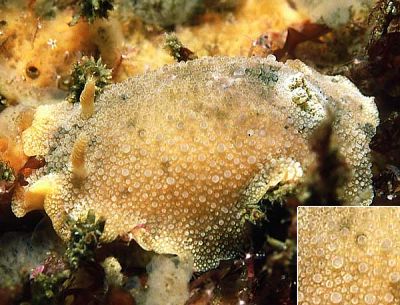
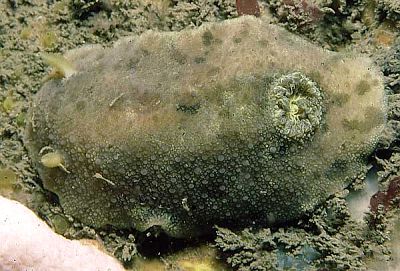
Archidoris pseudoargus
(Rapp, 1827)
Order: NUDIBRANCHIA
Suborder: DORIDINA
Family: Dorididae
DISTRIBUTION
European coast from Norway to Spain, and the Mediterranean. from intertidal to 300m.
PHOTO
UPPER: NE Soay, St. Kilda, Scotland - 22 Aug 1985 - 6cm. LOWER: Ruecallan, Rathlin Is., N. Ireland - Jun 1988. Photos: Bernard Picton
Large dorid reaching over 120mm in length. Common in the British Isles where it is known as the Sea Lemon. Mantle covered in blunt tubercles, and has a mottled colour pattern of brown, pink, green, yellow and white blotches. Feeds on siliceous sponges including Halichondria panicea and Hymeniacidon perleve. In much of Europe it is identified as Archidoris tuberculata Muller, 1778.
Archidoris pseudoargus is often confused with another large dorid Geitodoris planata. As discussed below by a number of participants, there are distinguishing features. Unfortunately they are more apparent in the field than in photos. Geitodoris planata can be distinguished from Archidoris pseudoargus by the light coloured stellate patterns on the mantle (acid glands), and also by the more flattened shape. The underside of the animal is also important with Geitodoris planata having brown spots on the mantle, and conspicous oral tentacles, both characters lacking in Archidoris pseudoargus. In living animals there is a difference in texture, Geitodoris being crisper, harder and flatter.
Reference:
• Thompson, T.E. & Brown, G.H. (1984) Biology of Opisthobranch Molluscs, Vol 2. Ray Society: London.
Rudman, W.B., 2001 (June 12) Archidoris pseudoargus (Rapp, 1827). [In] Sea Slug Forum. Australian Museum, Sydney. Available from http://www.seaslugforum.net/find/archpseu
Related messages
Archidoris pseudoargus - mass mortality in south Wales
August 13, 2008
From: Judith Oakley
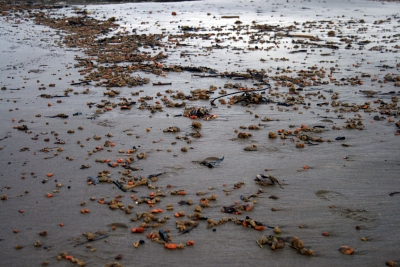
Hi Bill
There were hundreds of sea lemons Archidoris pseudoargus washed up dead after gales and storms on Bracelet Bay beach, Mumbles, South Wales on 11 March 2008. Alongside them were many chunks of sponges that I presume they were feeding on off-shore in shallow water.
regards
Judith Oakley
jomoakley@binternet.com
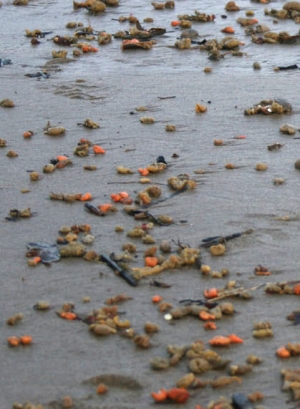
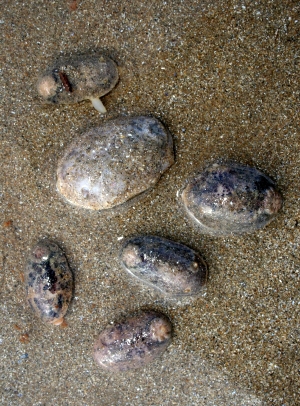
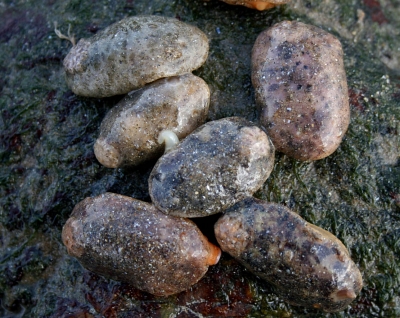
Dear Judith,
I usually think of sea hares when I think of mass mortality events like this, but I guess when the right conditions create a high density assemblage of any species, it has the potential, if things go wrong, to become a 'mass mortality event'.
Best wishes,
Bill Rudman
Re: Unknown Dorid from Italy
July 2, 2007
From: Sylvie Grall
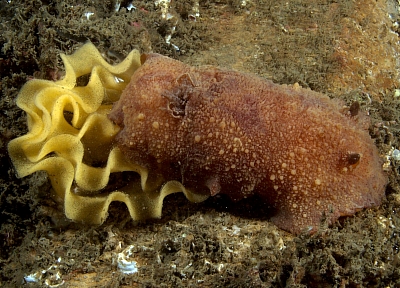
Concerning message #16985:
Dear Bill,
I am sending the pictures of a seaslug I identified as Archidoris pseudoargus as I couldn't see any clear stellar pattern on its back.
There were several specimens and eggs coils. These are also very similar to the eggs coils of Platydoris argo.
Locality: Barcarès, 20 m, France, Mediterranean sea, 13 may 2007, Artificial reef on sand. Length: 7 cm. Photographer: Sylvie Grall.
I'd very much appreciate if anybody could confirm this ID.
Thank you.
Sylvie.
sylvgrall@aol.com
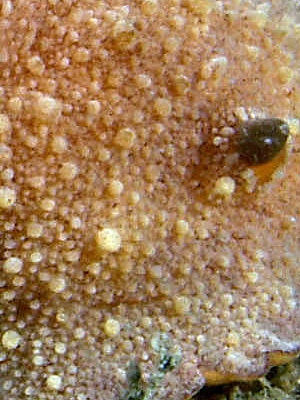
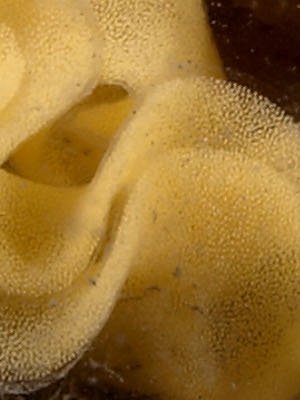
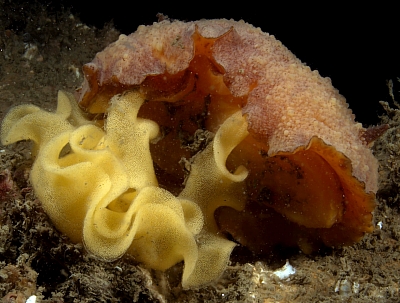
Dear Sylvie,
From this far away I need some local help. I suspect it is Archidoris pseudoargus from the mantle tubercles, which are in two sizes, and the uniform orange colour of the underside. However I would appreciate some confirmation from a local expert.
Best wishes,
Bill Rudman
Archidoris tuberculata? from Italy
April 21, 2006
From: Tancredi D'Onofrio
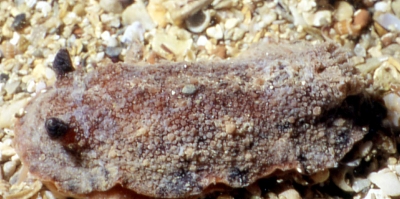
Hello, I'd like to ask if this is an Archidoris tuberculata Cuv. : about 6 cm, with blackish papillae. Is this a different species than Archidoris pseudoargus? Sorry if the quality of the picture is not so good.
Locality: Gulf of Trieste, 5 m., Italy, Northern Adriatic, Jan.-Feb. 2005. Length: 6 cm. Photographer: Tancredi D'Onofrio
Thank you,
Tancredi D'Onofrio
donofrio2t@libero.it
D'Onofrio, T., 2006 (Apr 21) Archidoris tuberculata? from Italy. [Message in] Sea Slug Forum. Australian Museum, Sydney. Available from http://www.seaslugforum.net/find/16324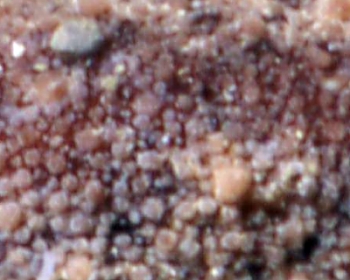
Dear Tancredi,
Archidoris tuberculata Cuv. and Archidoris pseudoargus are the same species. I am afraid the longstanding confusion between these two names seems to be partly a result of the historical - how shall I say - 'entente (sometimes) cordiale' between the English and the French. Cuvier misidentified this species with Doris tuberculata Muller, 1778. It was clarified by English workers who use A. pseudoargus but this has largely been ignored by French and continental workers. If we follow the most recent work we should really call it Doris pseudoargus.
Best wishes,
Bill Rudman
Two nudibranchs from Reykjavik, Iceland
September 30, 2005
From: Freyja Imsland
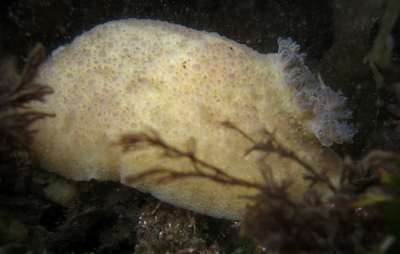
These are pictures of two nudibanchs that were found in an intertidal area on a very low tide at Ægissíða in Reykjavík, Iceland. This is a wide intertidal area where seeweeds blossom, in a creek that is enclosed in a bay. Even though it is in the middle of a city, the area is not polluted, neither with silt nor with offal. The nudibranchs were just past a bank of sorts so they were in deeper water than would have become un-submerged, even at a tide even lower than that day.
Locality: Ægissíða, Reykjavík, Iceland. Atlantic Ocean. Depth: Probably -0.4 m. Length: 70 mm and 59 mm. 18 September 2005. Slightly subtidal, area heavily covered in seaweed. Photographer: Freyja Imsland
Freyja Imsland
freyjai@hi.is
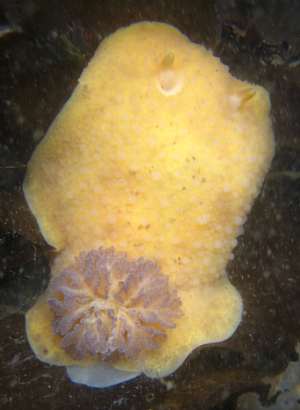
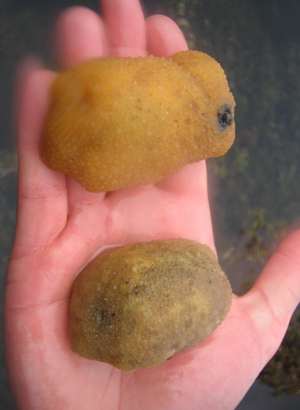
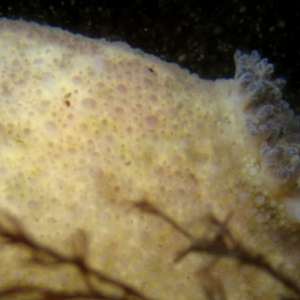
Dear Freyja,
I think this is the first nudibranch message from Iceland. Welcome to the Forum!
I am pretty sure this is Doris pseudoargus. The mantle is covered in small rounded tubercles of two sizes, which is one of the characters which you can use from your photos to separate this species from another large tuberculate Atlantic dorid called Geitodoris planata. There are other differences which I discuss on the Archidoris pseudoargus Fact Sheet. I should have changed the name on the Fact Sheet to Doris pseudoargus before now, because in a major revision of the group, Ángel Valdés showed that there were no good reasons to maintain the genus Archidoris. Unfortunately I have had too little time for 'house-keeping' on the Forum in the last few months. Hopefully I can find time in the near future to do this
- Valdés, Á. (2002) A phylogenetic analysis and systematics revision of the cryptobranch dorids (Mollusca, Nudibranchia, Anthobranchia). Zoological Journal of the Linnean Society 136: 535-636
Best wishes,
Bill Rudman
Identifying Archidoris pseudoargus
June 13, 2001
From: Bernard Picton


Hi Bill,
I've looked again at the messages on your Archidoris pseudoargus and Geitodoris planata Pages. Peter van Bragt's animal animal and Michel Barrabe's are certainly both Geitodoris planata. Angel Valdes picture is the only one which really is Archidoris pseudoargus. As Jussi says in his message, the best feature for Geitodoris are the acid glands - larger tubercles with a stellate pattern around them, which are usually paler. The gills are much bushier and retract into a different shaped pocket. With specimens rather than photographs it is easier as there is a difference in shape and texture, Geitodoris is crisper/harder and flatter.
I've attached some Archidoris pictures here, and some of Geitodoris in a following message. Probably more than you need, but I like the way the forum allows illustration of a range of colour variation.
On the west coast of Ireland I've often observed smaller animals with small spawn coils and I wonder if this species can reproduce for a long time at different body sizes, or even live for two years, reproducing twice (if reproduction is seasonal). See separate message for photos of mating and egg ribbons of typical animals and the smaller ones mentioned above.
UPPER PHOTO: NE Soay, St. Kilda, Scotland - 22 Aug 1985 - 6cm
LOWER PHOTO: Ruecallan, Rathlin Is., N. Ireland - Jun 1988.
Bernard
bernard.picton.um@nics.gov.uk
Picton, B., 2001 (Jun 13) Identifying Archidoris pseudoargus. [Message in] Sea Slug Forum. Australian Museum, Sydney. Available from http://www.seaslugforum.net/find/4549Dear Bernard,
Thanks for this explanation. I have replaced Peter's photo at the top of the page. Most people think that large, relatively common dorids, must be easy to identify. I think I have more problems with large 'flat dorids' than any other group of nudibranchs. Usually a single photo is not sufficient, often we need to see a closeup to show the texture of the skin on the back, and photos of the underside to show the head, and to show the colour of the foot and the ventral surface of the mantle.
best wishes,
Bill Rudman
Reproduction in Archidoris pseudoargus
June 13, 2001
From: Bernard Picton
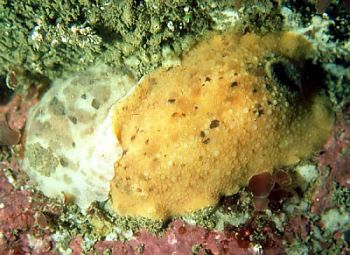
Hi Bill,
Here are some mating and egg-mass photos of Archidoris pseudoargus to accompany my other message.
The mating photo (upper right) shows how variable the colour pattern is in this species. On the west coast of Ireland I've often observed smaller animals with small
spawn coils (lower left) and I wonder if this species can reproduce for a long time at different body sizes, or even live for two years, reproducing twice (if reproduction is seasonal).
UPPER RIGHT: Copulating pair - Ballintoy Harbour, Co Antrim, N. Ireland, Feb 1976
LOWER LEFT: Small form and spawn coils - Rathlin O' Birne Is., Co Donegal, Ireland. Aug 1986.
LOWER RIGHT: Typical spawn coil - Ballintoy Harbour, Co Antrim, N.Ireland, Feb 1976.
Bernard
bernard.picton.um@nics.gov.uk
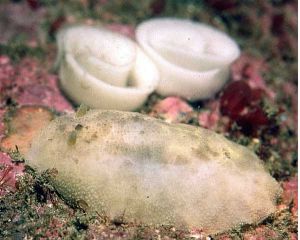
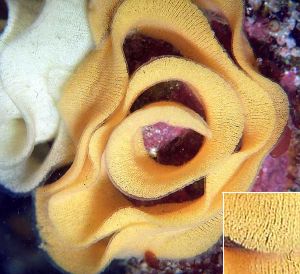
Thanks Bernard,
Are the yellow and white typical spawn coils in your Ballintoy photo evidence of a range of egg colour in the population or does the egg change colour during development?
Best wishes,
Bill Rudman
Re: Dorid from France
August 11, 2000
From: Angel Valdes
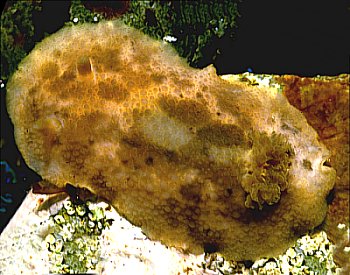
Dear Bill,
I think Peter van Bragt is correct. The specimen in the photo seems to be Archidoris pseudoargus Rapp, 1827. The problem is that the picture is a little blurry and a positive identification is difficult. I forgot that I had a picture of Archidoris pseudoargus that looks like the specimen from France. You might want to include if for comparison. The photo is not that great, but the specimen has been properly identified, with anatomical studies.
Regarding the name of this species, I believe the oldest available name for it is Archidoris pseudoargus. The drawings in the original description of Doris tuberculata (Müller, 1778) clearly represent a phaneobranch dorid, probably a species of Adalaria or Onchidoris. The identity of Doris tuberculata has not been determined yet, but it is definitely a different species. Most authors who used the name tuberculata for Archidoris pseudoargus followed Cuvier's (1804) paper. He was the first person to use the name Doris tuberculata for specimens of Archidoris pseudoargus.
Literature cited:
• Müller, O.F. (1778) Molluscorum marinorum Norvagiae, Decas 1. Nova Acta Physico-Medica Academiae Cesariae Leopoldino-Carolinae 6: 48-54.
• Cuvier G. L. (1804) Mémoire sur le genre Doris. Annales du Muséum National d'Histoire Naturelle 4: 447-473, pls 73-74.
Angel Valdes
avaldes@calacademy.org
Valdes, A., 2000 (Aug 11) Re: Dorid from France. [Message in] Sea Slug Forum. Australian Museum, Sydney. Available from http://www.seaslugforum.net/find/2861Dear Angel,
Thanks for the confirmation and the photo. And sorry about the name change Peter. I am afraid these things aren't really voluntary. Every now and then we have to sacrifice a favourite name for the sake of stability. I remember years ago being very concerned with having to change the name of the chromodorid genus Casella to the much older Glossodoris. Today most workers wouldn't know what I was talking about if I used the name Casella.
Best wishes,
Bill Rudman.
Re: Dorid from France
August 10, 2000
From: Peter H. van Bragt
Dear Bill, Erwin and Michael,
Looking at the picture of the dorid from France, I would certainly consider this animal to be Archidoris pseudoargus (We prefer to call it A. tuberculata, Muller 1778). At the moment is is found rather frequently in the Oosterschelde, a marine bay in the south west of the Netherlands). You have a picture on the Forum. That specimen seems to be feeding on a sponge. Possibly this is Halichondria panicea, the sponge on which A. pseudoargus typically feeds. Anatomical clues are furthermore the short blunt tubercles. The colour is of course not the best determination key, as this species is described by Bernard Picton as possibly being yellow, brown, pink, green and white.
With Dutch greetings,
Peter H. van Bragt
vanbragt.phjm@hsbrabant.nl
van Bragt, P., 2000 (Aug 10) Re: Dorid from France. [Message in] Sea Slug Forum. Australian Museum, Sydney. Available from http://www.seaslugforum.net/find/2854Dear Peter,
I am afraid these flattened rather nondescript dorids are rather difficult to identify without a good background knowledge of the fauna. We have a number in eastern Australia which I still find difficult from photos.
Your identification seems reasonable enough, but before I change filenames and links etc, perhaps I should ask if anyone can help confirm Peter's suggestion, or suggest an alternative.
Bst wishes,
Bill Rudman.
